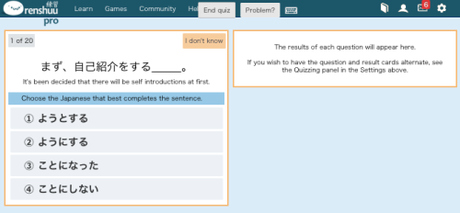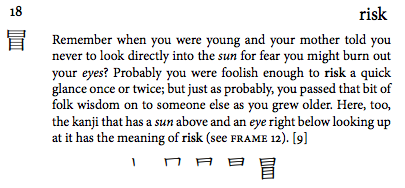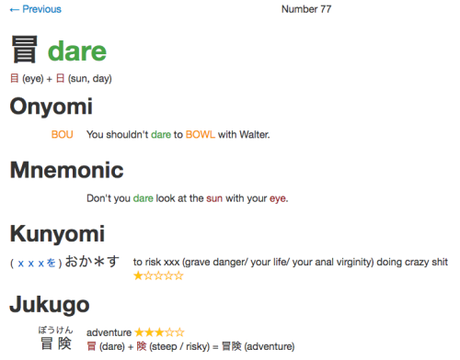Learning a new language can seem impossible, especially later in life, but it’s not–in fact, language learning is something our brains specially evolved to do! In this post I’ll share why why language learning is fascinating from a neuroscience perspective, my experience learning Japanese from scratch at twenty-eight, and end with three tricks for self-study that I learned along the way.
Language is a miracle, where neurons signal between brains by vibrating throat flaps
Just imitating a word is amazing. Think about it, we hear a word and then somehow figure out how to vibrate flaps in our throat to produce the exact same sound–what?! And that word spans a wide space of sounds–it can be said at different pitches, with different intonations and accents–yet we can hear that word through the roar of a crowded cocktail party. But speech recognition and imitation are just the beginning–we learn to impute the meaning of so many other words, just be hearing them or seeing them in context, and then using grammar can combinatorially recombine words into an infinite number of sentences, which can by understood by the listener even if they have never been uttered before in history.
Part of why language feels so miraculous, is because it is a human super-power. While animals like songbirds have the vocal imitation part down, and we can teach commands to dogs and rudimentary sign language to apes, we seem to be the only species specially wired to learn language, particularly when we’re young. I regret that I didn’t take advantage of free language classes when I was younger, but as cliche as it sounds, it’s never too late. Let me introduce you to Sally.
Sally: grandmother, and my roommate
My first year of med school I rented the cheapest room I could find, and ended up living with Sally, a sixty-year-old librarian, who spent her free time taking French lessons over skype and watching French mystery shows–or as netflix called them ‘Foreign TV Shows with a Strong Female Lead.’ Before living with Sally, I thought studying language was a chore, that I had to put up with because it was the only way to get to something I coveted–this magic shimmering concept–FLUENCY.

But as I saw with Sally, and then learned for myself, the process of studying a language itself can be a joy. And, gradually understanding a new language, feels like you’re pushing open a set of double doors, and peering out through the crack at more and more of a whole new technicolor world. It’s exciting and rewarding, and probably quite literally involves a slow drip of dopamine into your brain’s reward systems, as you make and solidify new connections.
Hello Tokyo – Walking through life with duct-tape over your mouth
Last year, at twenty-eight, I took an opportunity to work in a neuroscience lab at the University of Tokyo. I had studied a bit of Japanese in high school ten years earlier, but wasn’t any good at it (in fact, I dropped the class my senior year because it was weighing down my GPA). So I had more memories of struggling with Japanese than of the language itself. I gave up on Japanese, completely dismissed it, and took Spanish in college.
But this time-around I was motivated to learn and knew more about studying efficiency. During my year in Tokyo, studying Japanese started as a hobby–I had the simple goal of being able to comfortably walk into a restaurant and order from a Japanese menu–but learning Japanese ended up opening so many doors for me, and became an extremely rewarding part of my stay. But I’m getting ahead of myself, I showed up in Japan with a large rolling suitcase, printed out directions to the dorm where the university was putting me up, and pocket-sized copy of Japanese for Busy People

I was terrified there would be some snafu–I’d get lost, do something wrong, and end up in some situation, where no one spoke english and I’d have no way of explaining myself. In my first month in Japan I learned two contradictory lessons. First, it’s amazing how much I had taken language and communication for granted. Second, I also learned how inessential language is for communication. Before I left, I read a tongue-and-cheek blogpost about how to best prepare for living in Japan, where the author instead of suggesting instead of wasting your time studying Japanese, you should cover your mouth with duct tape for a week and go about your life. And for the first couple months in Japan, the language barrier entry was so steep, I did a lot of pointing, gesturing, and awkward apologetic smiling. And you get by in Japan without Japanese–I met people who had lived in Japan for over a decade without learning the language, though that seems horribly isolating to me.
Things finally start coming together
At first, learning Japanese felt like treading water, I was studying just to stop forgetting what I’d already studied, but I didn’t feel like I was going anywhere, like there was any real-life improvement. But then, the sensory learning started coming online, and it was a simple pleasure when a new word snaps into focus–like the lightbulb moment when you finally understand the stream of incomprehensible sounds that guy at the convenience store makes, is him asking you if you want your meal heated up.

Likewise, when you learn a new kanji (Japan’s logographic characters adopted from Chinese) and it suddenly pops out at you from that sign you’ve been passing for days–oh shit, that place was an izakaya, who knew?
I found these feats of sensory learning the most dramatic, because words switched seemingly instantaneously from something seeming completely unknowable, to something as obvious as night and day. All from the hard work of neurons somewhere deep in sensory association cortex making the right set of new connections. Sure I had to study, I had to put the right inputs into my brain, to allow my brain to make these connections, but the actually hard part, the miraculous part, was all unconscious.
How I studied
It took about six months before, I could talk and understand Japanese well enough to make friends with whom I only spoke Japanese–though having a cellphone handy for key nouns and verbs was always useful, and after a year of studying pretty intensely in my free time, I’d still classify my Japanese as conversational and nowhere near fluent. I chose to focus on communication–understanding and being understood–I didn’t worry about minor grammatical mistakes where I did something wrong but people could still understand me (like memorizing counters–go-fun as opposed to go-pun, who gives a fuck?)
My studies were about a third formally learning grammar from a textbook (Genki I and Genki II), a third learning and quizzing myself on vocabulary and kanji using spaced repetition, and a third everyday conversation with friends or at meetups and bars. Along the way I learned a number of useful tricks and I’d like to share them here:
Three Tips and Tricks for Language learning

Study every day in your down time with a spaced repetition app.Keep track of words you learn, and make it as easy for yourself as possible to study them in your down time. I recommend the creatively-titled app, “Japanese” by Renzo, inc. (itunes) (google play), like it’s slogan says, it’s more than just a dictionary. It let’s you add the words you look up to lists, and then quiz them using spaced repetition. (Quizzing, or forced recall, is a great way to memorize things, and spaced-repetition is the best way to make use of your limited time.) If you’re studying from your computer, renshuu is great. Like that app, renshuu has a built in dictionary, example sentences, and other features, so you spend less time crafting your flashcards and more time actually studying them. One of its coolest features is that vocabulary words start out in the alphabetic hiragana, and then as you progress through your studies, and learn their kanji, your vocabulary lists will automatically starts using it as well.
For listening comprehension, Netflix is your friend.Almost all new netflix series have dubbing and subbing in Japanese, and netflix carries a host of other shows with Japanese. You can vary the difficulty of your listening comprehension, by picking the type of show, subtitle settings, and using the videospeed controller plugin for chrome to slow down audio.
– Want something easy? watch a kids show at 70% speed (after this point the distortions are such that it may become harder to understand), and just english subtitles. See if you can pick out certain words you’ve already learned, or new ones from context. When you do you can double check them in that Renzo “Japanese” app on your phone, and then if you want directly add them to a list to get quizzed later. This is best when you don’t have a big vocabulary, and are more trying to parse sounds and sentence structures.
Another fascinating part of this process is seeing how culture and humor gets translated, when American characters eat, did the translators add in an ‘itadakimasu’? In a show with a laugh track like Friends, sometimes the joke doesn’t get translated at all, probably leaving the Japanese audience baffled as to why Americans think ordinary sentences are funny, and maybe one of the origins of the phrase ‘American joke.
– A little harder? Once you have your listening basics down, switch off the English subtitles and switch to Japanese subs. You can stay at 70% speed, especially if you want to keep studying in the middle of the show. Now you can look up vocabulary as you go, or even take snapshots with google translate, to see vocabulary from the subtitles. This may be especially helpful if you keep seeing a kanji you haven’t taken note of before.
Many netflix subtitles and dubs are separate translations of an english show, so it can be very interesting to notice when they diverge–it’s a good lesson in learning different ways you can express the same idea, and sometimes it can be fun to listen back in the original english and try to decide which seems closer to the original intent.
With this strategy, studying can be a breeze, and before long you’ll be listening to shows full speed without any need for subtitles.- Learn Kanji using mnemonics and visualizationA recommendation I heard over and over again (and once even unsolicitated by a stranger on a train), is James w. Heisig’s Remembering the Kanji (RTK) method for learning Kanji. (Here’s a sample of an old edition I found available online for free!) This book uses the technique of breaking down a kanji into their component parts or radicals. So for example, here’s out they teach a kanji that loosely ‘means’ risk:

This character can be broken down into the radical for sun and the radical for eye. This example is trivial and obvious, but figuring out how to break down more complex kanji is more complex–and memorizing and distinguishing them from related kanji without using this kind of technique can be nearly impossible.Heisig’s RTK, also recommends binding each radical and kanji into your mind to a single english word, and a strong mental image, rather than a nebulous concept. Then by combining radicals into new images, you can create visual mnemonics to help you decode and remember how to write every kanji.Using RTK combined with spaced repetition quizzing, I learned the meaning of 1,000 kanji, and how to distinguish them from one another, over my first six months in Japan. However, RTK won’t help you much with actually learning how to read. In addition to parsing the kanji themselves, most kanji have two or more phonetic readings, and japanese writing doesn’t put spaces between words, so you have to figure out where words are starting and ending through pattern recognition.
Kanji Damage – So after six months, I changed over from learning kanji through the RTK method to using Kanji Damage, a site with rather immature and sometimes offensive humor, that also uses a radical based approach to not only distinguish between kanji but also provide you with mnemonics to help remember their main readings and learn some related vocabulary as well. Remember the kanji for risk? Kanji Damage translated here as dare, and gives a mnemonic for the chinese reading or ‘onyoumi.’Even if you’re not particularly interested in reading or writing in Japanese, learning kanji can be helpful for learning vocabulary. It’s a bit like learning the greek and latin roots in english in that it can help you remember words more easily and guess the meaning of new words you’re hearing for the first time.
I’m out of time for tonight, but I’ve got some more language learning tricks in my bag. Please follow me on twitter, or follow this blog if you’re interested in learning more. I’m planning to write out posts about the best ways to learn japanese by listening to podcasts, and how to efficiently self-study on your own from textbooks.
Advertisements
